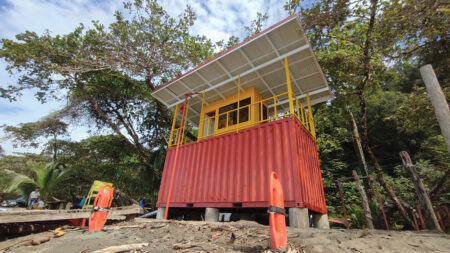Life Guards Costa Ballena
 Costa Rica has some of the most beautiful beaches in the world. They are also some of the deadliest. Each year on average 50 people drown from the dangerous riptides that form along the shoreline. Drowning is the second leading cause of accidental death for residents AND tourists in Costa Rica. Since the tide change can be as much as four meters in a six-hour period, what seems to be knee deep water can be over a swimmer’s head only a few feet away.
Costa Rica has some of the most beautiful beaches in the world. They are also some of the deadliest. Each year on average 50 people drown from the dangerous riptides that form along the shoreline. Drowning is the second leading cause of accidental death for residents AND tourists in Costa Rica. Since the tide change can be as much as four meters in a six-hour period, what seems to be knee deep water can be over a swimmer’s head only a few feet away.

The country does not have a national lifeguard program. If you see a lifeguard on the beach, they are either paid through a private partnership, a local government, or are volunteers supported by the community. The towers are paid for by fundraisers or grants from local and international non-profits. Although most all lifeguards are certified in ocean rescue, CPR, and first aid, there are no national standards or certification programs specifically for beach lifeguarding.
One of the first lifeguard programs to be supported by a local government is in the town of Dominical. In 2018 the Municipality of Osa offered to pay for four lifeguards under a three-year contract. The Association of Lifeguards of the Southern Zone won the contract and were given funds each month for lifeguard salaries. However, the association still had to raise money for the maintenance of the lifeguard equipment, uniforms, medical supplies, and administrative expenses. Each year the business community, residents, and tourists contributed funds when needed.

In the last two years the lifeguards in Dominical and Playa Hermosa de Uvita made 43 rescues and more importantly 8,800 preventative actions, warning tourists and locals about the rip currents and directing to where it was safer to swim and avoid them. They also applied first aid to victims injured by surfboards or sting rays over 40 times. Every day of the year the lifeguards are in the towers from 9 a.m. to 5 p.m., watching over to protect swimmers and surfers.
In 2022 the association was awarded a $30,000 grant to rebuild the lifeguard tower in Playa Hermosa de Uvita. The donor was the Five Together Foundation, given through the help of Amigos of Costa Rica, both 501c3 non-profit organizations in the United States. Through crowdfunding they were able to purchase an all-terrain vehicle for getting to victims more quickly.
The contract with the municipality ended on January 1st, 2023, and the lifeguard budget was quickly depleted since they were still paying salaries, maintenance, and administrative expenses, which equals about $6,000 a month. They expect their ability to pay for lifeguards with just private donations will end right before the holidays, when their services will be needed the most.
Currently at the national level a committee has been formed, with representatives from the ICT, local government officials, and current lifeguard group administrators. They are working on a national standard to certify lifeguards for ocean rescues, and a way for lifeguarding programs to be created and sustainably funded to protect more beaches. But the progress is slow and funding the program has to be ultimately approved by Congress.
The crisis of not having enough paid qualified lifeguards to protect the beaches of Costa Rica needs to be solved as soon as possible. They are directly saving lives in our communities and their presence makes it safer for everyone. Local municipalities and the ICT need to act now to fund lifeguards in public beaches that are shown to be dangerous for swimming. And more local hotels and rental property owners need to get involved in order to maintain safe beaches for their guests. Each rescue made by the lifeguards makes it an even more worthy investment.
For more information on the lifeguard program on the Costa Ballena and to make a donation visit lifeguardscostaballena.com and to get involved email lifeguardscostaballena@gmail.com.
